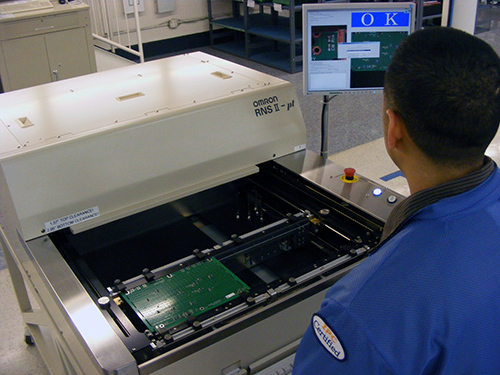Benefits of Defect Data Recording and Analysis

The payoffs are seen in yield improvement and better customer communication.
In a perfect world, design and manufacturing teams work together to minimize defect opportunities prior to releasing a PCB assembly into production. Lessons learned over time are incorporated in design philosophy and the product and associated processes continually improved as a result. The muda, a Japanese word associated with the Toyota Production System concept of waste reduction, is eliminated prior to production start. In EMS, that is not always the case. The sheer variety of products, speed of product or engineering change order (ECO) release, or vendor-related quality issues enable defects and associated muda to slip in. While a proactive approach to minimizing defect opportunities is ideal, EMS companies also need to have a strategy for quickly identifying and eliminating the inevitable defects.
The first step is identifying which PCBs are the main drivers of defects. At SigmaTron International’s Elk Grove Village (IL) facility, a custom defect data management system has been integrated into the company’s proprietary iScore Product Management System to help in achieving this goal.
Every nonconformance found in production and test is entered into this program. The assembly number, shop order number and the product’s unique serial number are embedded in a 2D barcode. The user scans the product barcode and enters a specific code number to identify the defect found, the area in the product routing where the defect was found, the location of the defect per the boards’ component reference location, and a brief comment, if needed.
The system is set up to alert management and supervisors to defect trends occurring within a 24-hour period on products. The system generates an email defect alert when the same defect at the same location on a product has been entered into the system at 3, 5, 10 and 20 time intervals. This permits immediate corrective action to take place.
Defect reports can be generated at will for any date range, defect type, or product assembly number for analysis. The quality and production management
team meets once a week to discuss defect trends found on the highest-volume products and identify any other products that show defect trends. The team also tracks product returns, verifies complaints and takes corrective action steps to eliminate the rejections. From a Lean manufacturing perspective, a major goal is to identify the top generators of defects and strategize the options for eliminating the issue and the muda it generates.
SPC and AOI are the primary tools used to identify trending defects and better pinpoint the root cause. SPC points include an hourly solder paste inspection; AOI; and visual inspections at reflow, in-process after any secondary operations and at final packaging. Three databases are maintained: in-process, test and final audit. Filtering can be done to identify trending in specific areas and investigate why defects occurring later in the process aren’t being caught earlier.
In particular, this level of analysis helps fine-tune AOI programming. Operators are instructed to record all AOI-identified defects as a defect. Those are analyzed, and if the actual issue is a false positive, the programming is fine-tuned. For example, something as simple as a change in parts purchased off the approved vendor list can drive AOI defect flags for wrong component, if that component’s model isn’t in the parts library.
Similarly, specialized inspection visual aids may be created for trending defects that have little probability of being redesigned out.
In the Elk Grove Village facility, virtually all trending defects are part of mixed-technology PCBs. Often the issue is subtle and difficult to identify. The benefit of a strong defect data collection system is that defects are identified quickly and the magnitude of the issue and options for correcting it can be discussed quantitatively.
Examples of trending defects that were identified early and corrected include:
- An increase of defective capacitor components found during product testing. Since defects were found at the same locations, the root cause pointed to a particular vendor’s capacitor. The first-pass yield (FPY) was 94% at its lowest point, versus the facility goal of 98%. The quality team collected a number of samples de-soldered from failed boards and sent them to the vendor for analysis. The vendor confirmed that the capacitors were indeed defective but was unable to offer an explanation, suggesting only that it wasn’t compatible with the customer’s design. The customer was told of the issue and approved an alternate source for the part. The FPY on the next shop order was 99%. After being informed of the improvement, the customer removed the incompatible capacitor from its AVL.
- In another case, a product that had been running for a number of years at the facility started showing signs of a downward trend in FPY. It dropped to 97% from a 99 to 100% FPY average. After analysis, it was determined that that the problems were being caused by a reversed transistor that was auto-inserted from tape-and-reel. The initial assumption was that the operator was installing the reel into the machine in reverse. The operator insisted that wasn’t the case, so the root cause analysis continued. It was then observed that the vendor that performed the tape-and-reel operation starting from bulk parts had a system that didn’t ensure polarity on each and every part. In-stock reels were inspected for reversed components, and a number of reels had reversed parts in the tape. Photos and samples were then sent to the vendor, along with corrective action paperwork. A corrective action method then resolved the issue.
The value of this system isn’t simply in its ability to provide a tool for early identification of trending defects and initiation of corrective action. It also supports strong communication with the customer on drivers of defects in their products and documentation of the corrective action.

Figure 1. Filtering is used to investigate why defects occurring later in the process aren't being caught earlier. This level of analysis helps fine-tune AOI programming.
Ron Feyereisen is continuous improvement manager, SigmaTron International (sigmatronintl.com); ron.feyereisen@sigmatronintl.com.
Press Releases
- 2026 IEEE Electronic Components and Technology Conference Student Innovation Challenge Pre-registration Deadline Extended to January 11, 2026
- PCBsync PCB Assembly Introduces Full-Scale Electronic Manufacturing Service
- Magic Leap Partners with Pegatron for AR Glasses Components Production
- TEXMAC/Takaya Appoints ARK Mfg. as New Rep in Arizona







